Index


Review: Copes with Call of Duty 4
Point of View isn't the first company that will come across your mind if you are looking for a netbook. These guys had their share in making Nvidia graphics cards and are still Nvidia exclusive partners, something that is quite rare these days.
As of last year, Point of View has decided to join in on the netbook fun, and although we haven’t seen a lot of these, POV’s Mobii has always been around and has been selling in Europe for awhile now.
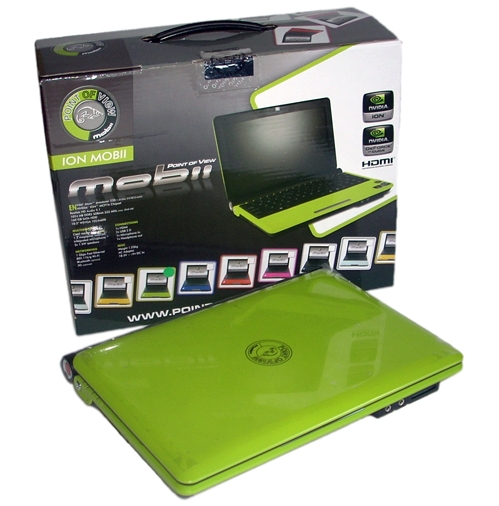
As of recently, Point of View has released a new Mobii netbook that features Nvidia’s ION chip under its hood, and as far as we could tell, Mobii ION was one of the first ION netbooks that has showed up in European retail/e-tail shops. As a matter of fact, the only other ION netbook that can be found in Europe is the Samsung’s 11.6-inch N510 AnyNet.
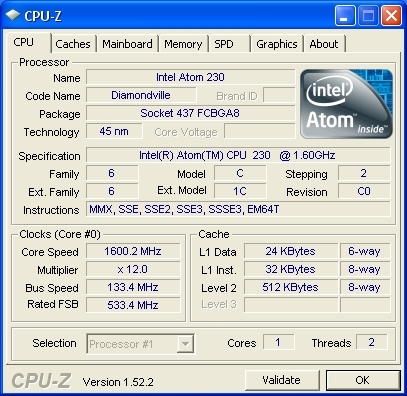
Due to Microsoft’s limitations, this one has pretty much the same specs as any other netbook on the market. It features Intel’s Atom 230 CPU working at 1.6GHz, Nvidia’s ION MCP7A chipset with Nvidia ION LE graphics, 1GB of memory and a 160GB hard drive. The ION LE is basically the same thing as the ION except for the fact that it only supports DirectX 9.
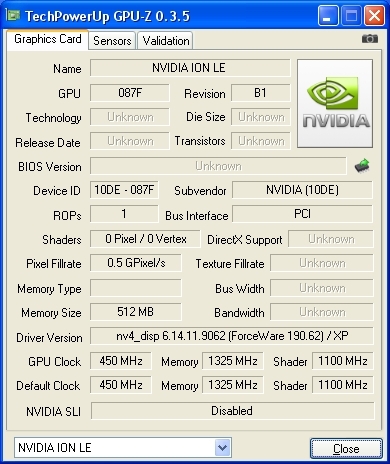
The rest of the features include Gigabit LAN, 802.11b/g WiFi, 1.3M web cam, two USB ports, card reader, Realtek’s HD audio, integrated two 1.5W speakers, and an HDMI output. The spec is more than adequate for Windows XP Home Edition, the preinstalled OS.
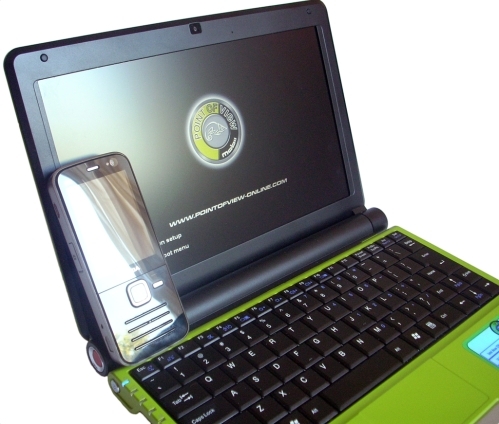
Unlike other manufacturers, Point of View decided to keep the 10.2-inch 1024 x 600 screen, the same one that was used on the older Mobii. We are also glad that POV decided to use a non-glossy screen as those glossy screens might look good, but in the words of our mobo reviewer Eliot, they only make sense if you are living on the dark side of the moon. (I can't even say what I think of them - kids read this, too, you know. sub.ed.)
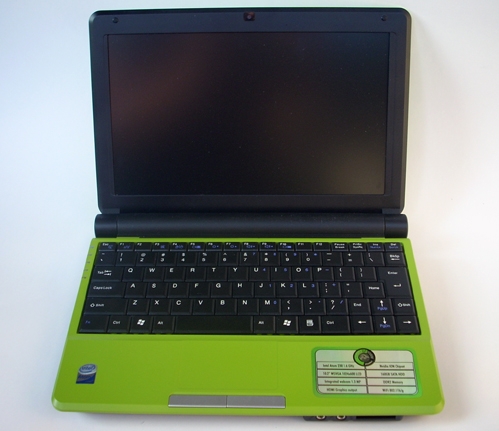
The screen has impressively high brightness and the colours are quite decent too, something that we didn’t expect from a cheap netbook. The 1.3M web cam is also pretty good, and works quite well even in low light conditions.
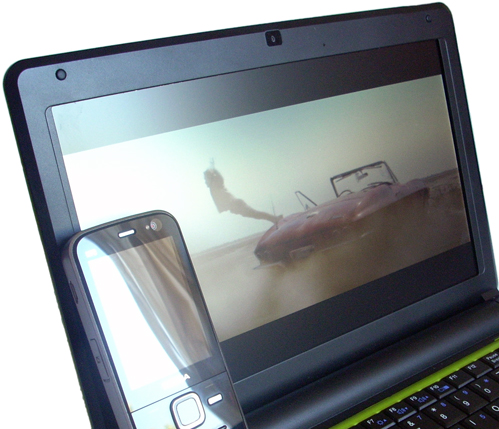
With 255x185x33mm dimensions, the Mobii ION mini basically has the same size as any other 10.2-inch netbook on the market, something that you simply can’t change because of the size of the screen and the general component layout. It weighs around 1.4kg with the 6-cell battery so it is quite light as well.
The Point of View Mobii ION mini ships with either 3-cell 2200mAh or the 6-cell 4400mAh battery. The down side of the 6-cell battery is that you get a hump on the back of the netbook. It acts as a stand, as it angles the keyboard, but it doesn’t bode well for the overall design of the netbook.
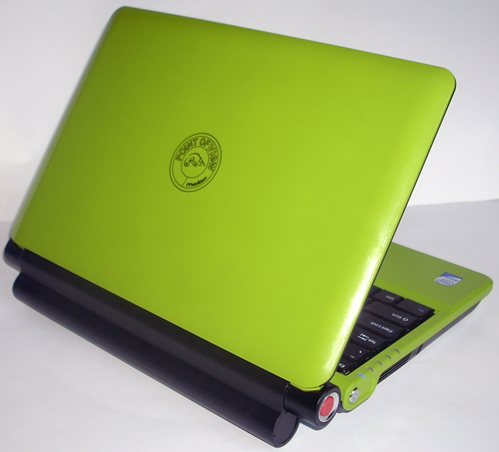
The design is simple and minimalistic but the colour options made it a bit more cheerful and the glossy finish on the lid is also a nice touch and adds some to overall quality of the product. The Mobii ION mini is available in four colours, plain black and white as well as a bit cheerful green and red. As you could see from previous pictures, we decided to go for the green, especially because this netbook is all about Nvidia and its ION graphics.
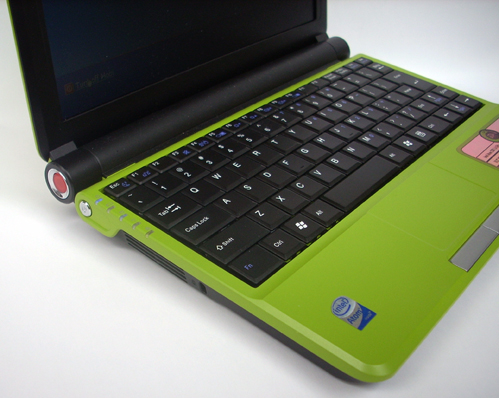
The chassis feels quite sturdy and we were quite surprised, especially due to the fact that Point of View isn’t a big manufacturer and honestly can’t compete with the likes of Samsung, MSI or Asus, but still they managed to produce a decent quality netbook. It does look a lot like Lenovo’s Ideapad S10, although it is less serious and not as dull as the Lenovo.
We are glad that Point of View decided to use the glossy finish only on the lid of the netbook, while the rest of it is sports a matte finish, especially the palm rest. Because of this, there will be few unwanted fingerprints and smudges on the palm rest, and the lid is rarely touched anyway.
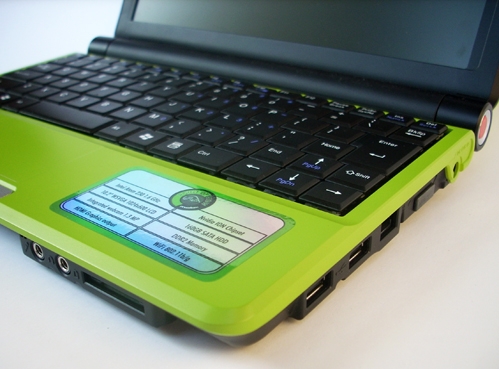
The hinges feel sturdy and the only thing that we didn’t like there is that red/chrome circle detail which really doesn’t do anything and it is purely decorative. The power button and the status LEDs are pretty simple.
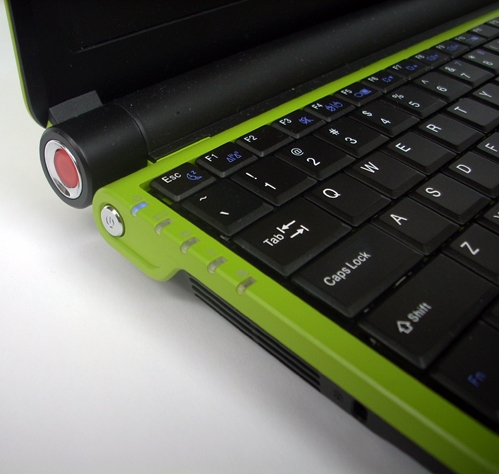
The position of the power button is a bit odd, and prone to accidental pressing, but we guess that POV had no choice here as they wanted to keep the keyboard and the touchpad as big as it is possible on a 10.2-inch netbook.
Keyboard and Touchpad
The keyboard is decent, at least when it comes to netbooks. It feels sturdy and you need a bit time to get used to the size, but that’s the case with all netbooks as they simply aren’t designed for prolonged use.

Same as on the Lenovo’s S10, someone decided that it is a good idea to switch the places of Fn and Ctrl keys, so you’ll end up with a bunch of failed “copy-paste” and similar “Ctrl” based shortcut actions until you get the hang of it. This is a minor inconvenience as you have to get used to the small netbook keyboard anyway.
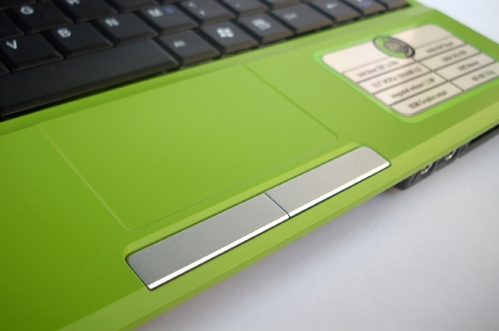
The touchpad feels quite good, and it is far from small with its 45 x 65 mm dimensions. Unfortunately, there is no scroll bar and you’ll have to deal with manual scrolling. The keys are quite solid and need a normal amount of pressure for that magic click as they are neither too sensitive nor too stiff.
Ergonomics
The POV Mobii ION mini is quite different when it comes to ergonomics as the left side is pretty much empty. It has a power button, status LEDs, exhaust for the fan and a security lock.
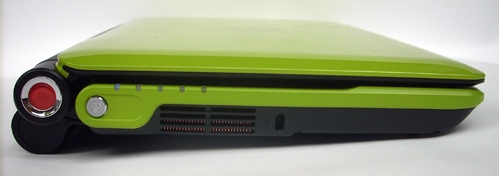
We already mentioned in the specification list that it only has two USB 2.0 ports and both of these are located on the right side of the netbook, along with the RJ45 LAN port, HDMI output and the power connector.

The front side is reserved for audio connectors and the card reader. We didn’t take the picture of the back side as this one only has a battery, so it’s far from interesting.

The bottom is pretty straightforward, it hides the battery hinges and two lids held by a pair of screws.
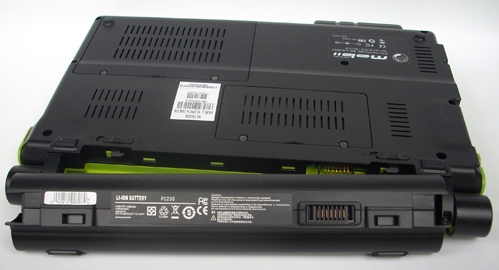
These two lids make the upgrade pretty simple as you can easily get to the memory and hard drive, practically the only two things that you can upgrade on a netbook.
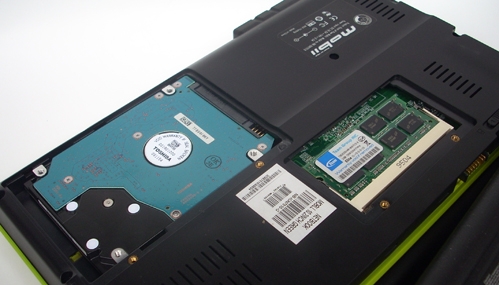
As you can see from the pictures below, our sample came with 2GB of Team Group 667MHz CL5 memory and a 2.5-inch 160GB Toshiba hard drive.
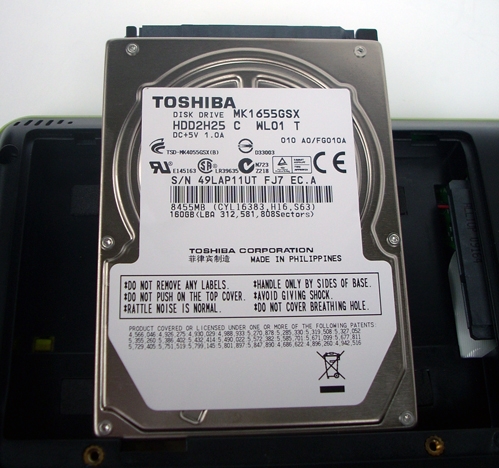
The retail sample comes with 1GB of memory but as memory is quite cheap these days we recommend upgrading it to 2GB as both Windows XP and Windows 7, if you decide to install it, will certainly appreciate it.
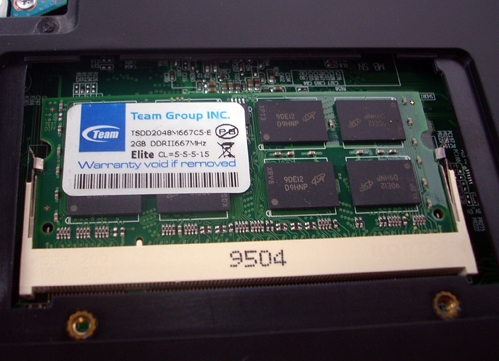
Benchmarks
If this is an ordinary netbook, we honestly wouldn’t even bother to run some benchmarks as it just seems pointless. Every netbook that we tested had the similar, if not the same results in benchmarks. The Atom CPU, whether it’s a Z530, N270 or the 230, has pretty much the same performance level, and we can't be bothered commenting Intel’s integrated graphics.
Thankfully, this is not an ordinary netbook, and you can certainly surprise a lot of people once you run Call of Duty 4 or play a full HD 1080p video over an HDMI output on such a tiny machine.
We’ll start with regular benchmarks that we usually run on any netbook or notebook that comes into our lab.
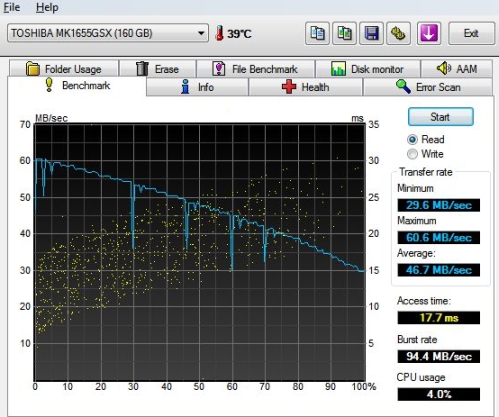
HD Tune shows decent performance similar to those of any other netbook that we had a chance to test. Lenovo S10e and MSI Wind U115 Hybrid scored pretty much the same numbers with their 160GB Western Digital drive, while Toshiba drive in POV’s Mobii ION had a slightly higher latency and also a higher burst rate.
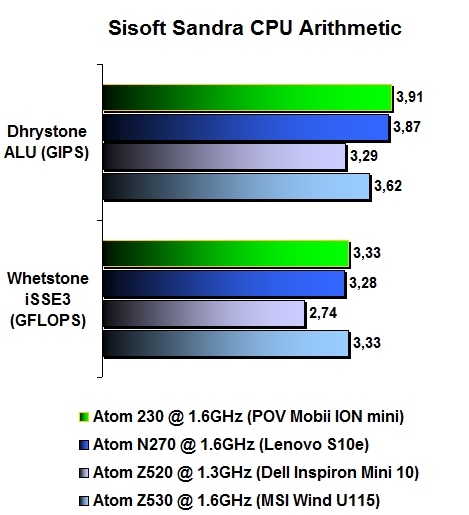
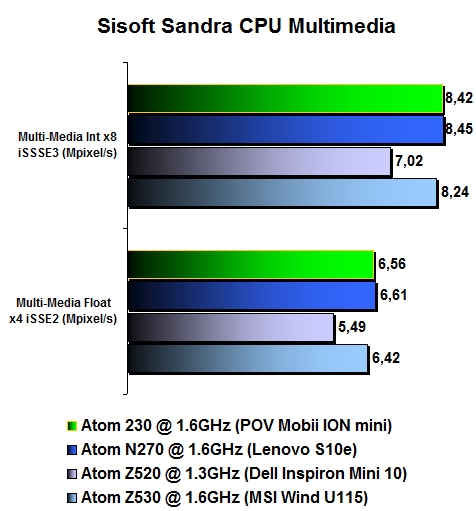
Sisoft Sandra tests show that all netbooks that we tested so far are pretty much on the same level even if they are using different model of Atom CPU working at the same clock speed.
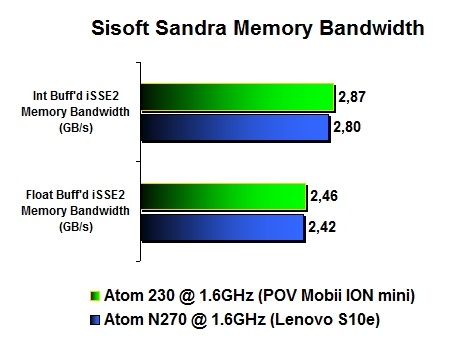
There is slight difference in memory latency but this can be attributed to different memory settings.
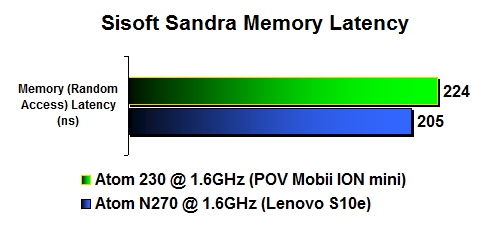
3DMark is where Point of View’s Mobii ION mini really shines. As this one is based on Nvidia’s ION LE chipset with 9400M integrated graphics, it can score a decent level of performance in 3DMark 2006. The test was done with default settings at 1024x600 which is native resolution for this netbook.
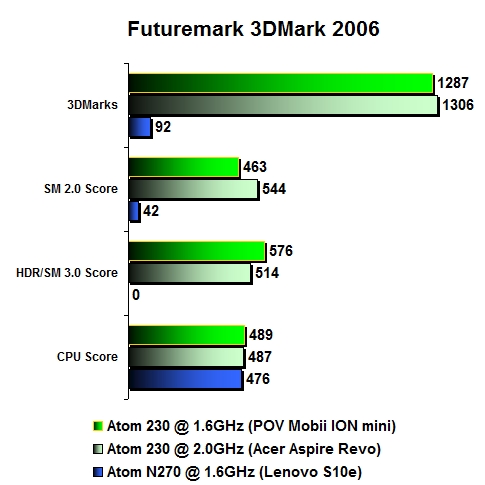
Just for reference, we decided to include Acer’s Revo ION nettop as well. You can check out our review of it here. Lenovo S10e is far behind as Intel’s integrated graphics is simply not enough for 3DMark, or anything else for that matter.
Games
In order to show that POV’s Mobii ION mini is quite capable of playing games, we launched Call of Duty 4 and FRAPS measured an average of around 25 frames per second at 1024x600 and lower details.
This means that it can also run some other games as well, as long as you keep the detail level down. We are quite sure that it will have no trouble with World of Warcraft, or other similar games for that matter.
Temperature and Noise
The POV Mobii ION mini gets pretty hot. Don’t get us wrong as it doesn’t go over 50 degrees Celsius at the left side exhaust and around 45 at the bottom of it. According to GPU-Z the ION GPU can heat up to 68 degrees Celsius under full load and hovers around 65 when in idle.
The fan is silent in idle and we had to check twice in order to see if it is actually spinning. But when pushed to do some heavy lifting, like for example, Call of Duty 4, you can hear it from time to time as it spins quite fast in order to cool down both the GPU and the Atom CPU.
This probably happens due to the fact that the ION GPU is clocked at 200MHz for the GPU and 400MHz for shaders in idle and only jumps to the reference 450/1100MHz once needed. There are also the 300/600 and 350/800MHz modes, which CPU-Z reports as 2D desktop clocks but we honestly haven’t seen these as they are probably used only briefly.
Battery Life
As we already told you, our sample came with 6-cell 4400mAh battery which is capable of keeping POV’s Mobii ION mini running for around 3 hours and 27 minutes in regular use, which is considered to be surfing over WiFi with a 70 percent screen brightness.
When pushed to play a movie with a 100 percent brightness, Point of View Mobii ION can give you around 2 hours and 20 minutes of constant playback, enough for most movies. We must note that even when playing a movie the GPU clocks up to 450MHz so this may be considered as the battery life under full load.
We didn’t want to miss a chance to install Windows 7 and try it out on Point of View’s Mobii ION. The specifications and performance are quite enough in order to pleasantly run Windows 7 with all the eye candy that you can think of. Of course, our test sample came with 2GB of memory while the retail one has only 1GB of system memory. We are quite sure that even with 1GB of memory Windows 7 experience will be decent.
We must confess that Windows 7 looks and feels good, and it's quite a bit more useful than the Windows XP, especially if you want to use everything that Nvidia’s ION has to offer. According to what we managed to find out, Point of View should launch Mobii ION mini with Windows 7 as well and we would certainly recommend it over the Windows XP version, especially if it comes with 2GB of memory.
When you compare a netbook with Nvidia’s ION graphics and a netbook with Intel’s integrated graphics you must mention a couple of things. For starters, Intel’s 945G isn’t capable of playing 720p video and we don’t even want to talk about 1080p, while Nvidia ION has no trouble with it, but we’ll get to that a bit later. Next in line is Nvidia’s CUDA, which can be used for a lot of things, but the one that is most important to consumers is the fact that it can accelerate video enhancement and transcoding, something that you may find very useful.
We tried Badaboom in order to transfer a video file to Zune, and it was significantly faster than on the notebook with Intel integrated graphics. There is also the MotionDSP vReveal for video enhancements, Cyberlink’s Mediashow Espresso and Power Director 7 and bunch of other programs which can take the advantage that Nvidia’s ION can offer.
Of course, we must not forget the fact that Nvidia has recently showed a GPU accelerated flash on ION as well. Although it is still not out, it will add additional value to ION-equipped nettops and netbooks.
The HD playback is one of the things were ION has the upper hand over any other netbook solution on the market. This means that you can turn your small netbook into a home theater system capable of playing both 720p and the 1080p video via HDMI output.
We now must go back to the Window 7 or Windows XP topic. As you all probably know, Windows 7 and Vista have EVR (Enhanced Video Rendering) and while this is enabled HD playback works like a charm. On the other hand, Windows XP doesn't have this, and it is a bit harder to make it decode HD content. We didn't say that it is impossible, just that it is a bit harder.
In order to get the x.264 720p/1080p HD decoding to work on Windows XP, you'll need the latest ION driver, latest DirectX version, a K-lite codec pack and Media Player Classic Home Cinema (GPU accelerated). Other combinations and options might work as well, but only this one made it possible for us. The key is to use Overlay Mixer, VMR7, VMR9 or VMR9 renderless inside the playback/output options of either your codec pack or the Media Player Classic options menu.
This way the CPU utilization is still higher than on Windows 7, but both 720p and the 1080p playback works like a charm.
Conclusion
Point of View certainly surprised us with its Mobii ION mini netbook. We honestly didn't expect that much from a €339 netbook. We were quite surprised to see that Point of View was one of the first manufacturers to get an ION based netbook to the European market and to be quite competitive with the likes of Acer, Samsung, MSI or Asus.
The only thing where Point of View can't compete with others is the fact that currently only few retailers/e-tailers have it in stock and your best bet is Alternate.de, which is not that bad as Alternate is surely one of the biggest European sellers.
Nvidia ION already bought us when we reviewed Acer's Aspire Revo nettop, but when you consider the fact that ION basically has no competition in this segment, as Intel's GMA 945G can hardly put up a fight, you can see why ION looks that good.
Don't get us wrong, Point of View Mobii ION mini is still a netbook, and you can never consider it a full time system as the keyboard and the screen are still too small for anything. On the other hand, having the possibility to turn your netbook into a full home theater system capable of hooking up to your 1080p TV via an HDMI cable and have no trouble in reproducing anything that you can throw at it is a real advantage over your regular netbook.
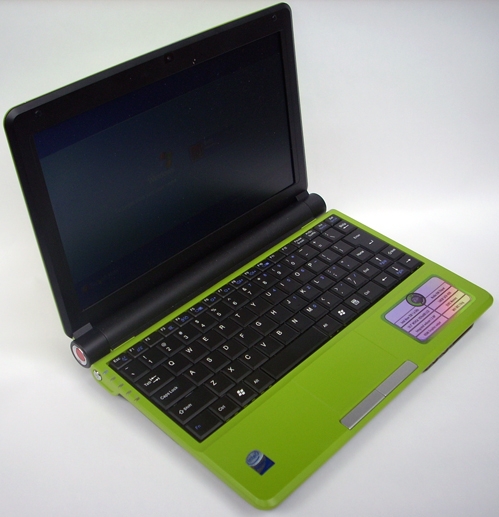
The direct competition for the POV Mobii ION mini netbook is Samsung’s N510-anyNet, which has a bigger screen, probably a bigger keyboard and uses Intel’s Atom N270 processor. Of course, as you can see from the tests, Atom 230 is practically the same deal as the N270 except for the fact that N270 might use less battery and be cooler due to its lower TDP. On the other hand, Samsung’s N510-anyNet is more expensive and can be found for around €450 so you pay quite a bit more for 1.4-inches of screen and a different CPU.
It is basically a matter of necessity, as you either want a super portable netbook with ION graphics that you can easily pull out from your bag and place on an airplane tray and watch HD movies or you want Samsung’s bigger one as you like to have a bigger screen and “slightly” bigger keys.
We can easily recommend the Mobii, as it has a decent, €339 price tag, looks good and surprising build quality. It silently took everything that we’ve thrown at it and made it possible, and it certainly will turn a head or two with its colour. If you happen to get a comment that it is actually just a calculator with a fancy screen, make sure that you have Call of Duty 4 installed as it would raise an eyebrow or two as well.
